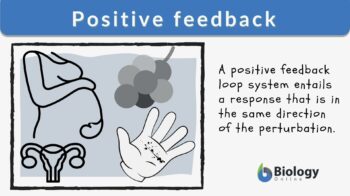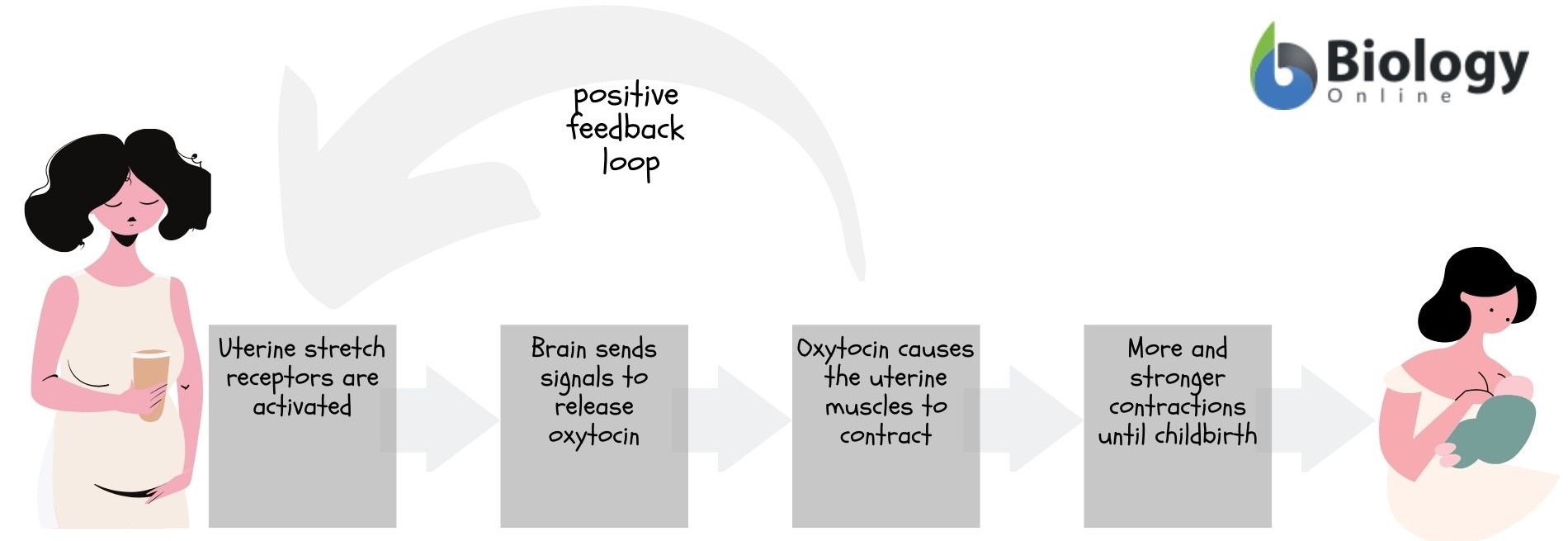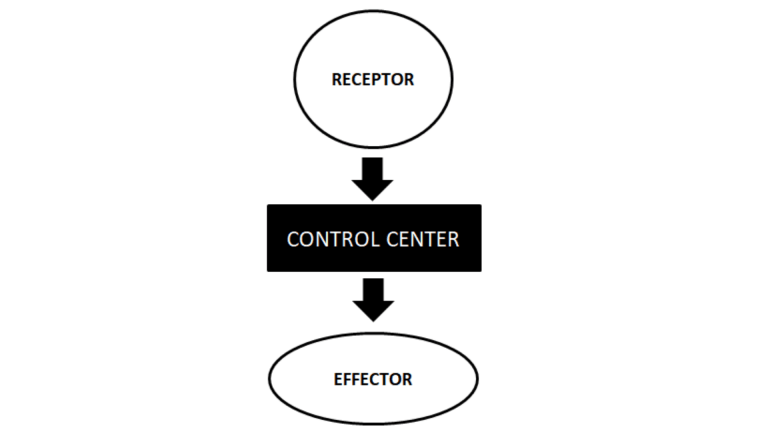
Positive feedback
n.
Definition: A loop system wherein the system responds to a perturbation. The response may be in the same direction (as in positive feedback) or in the opposite direction (as in negative feedback).
Table of Contents
Positive Feedback Definition
Each mechanism of the body like temperature, blood pressure, and levels of specific nutrients has to be in the optimum range so that the body can function properly. An optimum value is a normal value about which the standard range varies. Keeping the standard or optimum range keeps the body healthy and stable. Various biological mechanisms work on the input and output of the body given as the result of a certain stimulus.
The feedback loop contains two major forms: (1) positive feedback and (2) negative feedback. They work to maintain body equilibrium under different conditions. Feedback loops are biological mechanisms in which the living body’s internal stability is maintained depending on its response. It happens when the product of action or any output alters the body’s response.
What is positive feedback? Positive feedback is amplifying or magnifying the change or output. The response effect is magnified so that it can occur much faster. In this form of feedback, the output of the system is enhanced. Conversely, in negative feedback, the output is decreased or inhibited. In other words, in a positive feedback mechanism, the direction of the response is in the same direction as the initial change, resulting in a self-reinforcing loop. In a negative feedback mechanism, the direction of the response is opposite to the direction of the initial change, resulting in a self-regulating loop.
Feedback loops play an important role in order to preserve homeostasis. Homeostasis is the maintenance of an internal environment of the body from the harm and fluctuation of the external environment and helps in maintaining body stability.
Maintaining homeostasis depends upon two major factors:
1. Type of organism
2. Habitat of the organism
For example, a cold-blooded animal, like fish, maintains a lower body temperature according to the external environment whereas a warm-blooded animal like a whale preserves higher body temperature to maintain internal stability.
Positive feedback is known as a positive response or a self-reinforcing response to external or internal input. In this, the effector boosts up the stimulus that enhances the product formation for maintaining body stability. Positive feedback promotes a change in the physiological state instead of reversing it.
What is a positive feedback loop? Positive feedback involves a physiological system that reinforces the change (works to reinforce or intensify the change). The variation is sensed by the receptor, and then the effector works to produce an identical outcome – this enhances the physiological change. The actual change will continue to amplify by the positive feedback loop until the stimulus is removed.
Positive feedback is amplifying or magnifying the change or output. The response effect is magnified so that it can occur much faster. In this form of feedback, the output of the system is enhanced. Conversely, in negative feedback, the output is decreased or inhibited. It is characterized by having a system responding to the perturbation in the same direction as the perturbation and resulting in the amplification or growth of the output signal.Compare: negative feedback
Positive Feedback Examples
What is an example of positive feedback in homeostasis? Let’s take a look at some of the examples: clot formation, childbirth, fruit ripening, and menstrual cycle. Each one depicts what a positive feedback mechanism is like:
- Clotting factors are released to seal a wound
- At the time of baby birth, there is a dilation of the walls of the uterus that causes a contraction that encourages further stretching (this continues until birth)
- In fruit ripening, there is the release of ethylene, which will continue the ripening process of fruits
- In the menstrual cycle, the estrogen hormone promotes the secretion of other hormones that will lead to ovulation.
Blood clot formation
One of the major examples of positive feedback is the effort of the body in reversing the damage caused by any injury. When the body gets injured the major threat to life is excessive loss of blood. Blood pressure and blood flow at the site of injury are reduced. At the site of the injury, blood clotting factors are released to initiate blood clotting. Once the process begins it promotes the clotting process further. Thus, overall, the process of sealing the injured site is speeded up. Clotting factors are responsible for the formation of a clot in the injured or wounded area. This is one of the life-saving examples of positive feedback.

Childbirth
• The onset of contractions in childbirth is also known as the Ferguson reflex.
• In the case of childbirth, the growth of the baby eventually causes the uterine walls to expand, which is reflected by the stretch receptors
• This stretching will trigger the secretion of oxytocin hormones that activate the uterine muscles and it causes a reduction in the space of the uterus
• It causes more stretching of the uterus and consequently more contractions will happen until the original stimulus (fetus) is removed (i.e., birth)

Ripening of fruit
The ripening of fruit is another example of a system employing positive feedback. If you observe a plant or a tree bearing lots of fruits, you will notice the fruits go through the stages: from unripe to ripe to overripe. The process will start when the first fruit begins to ripen. When it is ripe, it releases a gas which is known as ethylene (C2H4). This causes the nearby fruits exposed to the ethylene to begin to ripen. As the ripening continues, these fruits also continue to release ethylene gas. This feedback loop is usually used in the production of fruits in which exposure to ethylene gas makes the ripening process faster.

Menstrual cycle
The estrogen hormone starts to release in the ovary before a female ovulates. The estrogen hormone travels to the brain and causes the secretion of two other hormones. The hypothalamus is activated to release gonadotropin hormone while the pituitary gland is stimulated to release luteinizing hormone. Luteinizing hormone, in turn, enhances the release of estrogen. An increase in the levels of these hormones as well as of follicle-stimulating hormones leads to ovulation.
Parts of the Positive Feedback Loop
There are four major four components involved in maintaining homeostasis. These are:
1. Stimulus
2. Sensor (Receptor)
3. Control Centre
4. Effector
Stimulus
The stimulant can be any external substance that disturbs the homeostasis of the body (it is the process of maintaining balance in all body systems). The stimulus is provided by controlled variables. In general, the stimulus causes the optimum range to be moved or fluctuate from the normal or standard range. Physical injuries, infections, or any fluctuation in the external environment are some cases of stimulus. They disrupt the physiological functions of the body.
Sensor
The sensor is also known as the receptor. This component of the feedback system detects physiological value. The sensor senses the variation in body equilibrium. It not only monitors the extent of change but also sends signals to the control center. For example, nerve cells of the cervix perceive the fetus’s head pressure during childbirth. The sensory nerves from the sensor will report the change to the control center.
Control center
The control center is a part of the feedback system that compares the extent of fluctuation to the normal value. It not only receives signals from sensors but also processes the information. The control center in the brain detects the changes and compares them with the normal values. If the value is not within the optimum range, an immediate signal to the effector is sent by the control center to maintain body equilibrium.
The pituitary gland is located near the brain, which is the control center of numerous response processes. Various hormones like oxytocin, antidiuretic hormone, and growth hormone are released from it, in response to the stimulus.
Effector
The effector can be any muscle, organ, gland, or any other structure that gives a response to the stimulus according to the signal received from the control center. The effector either opposes or enhances the stimulus. The response of the effector depends on the command received by a control center.
The goal of the effector is to maintain stability by moving the variable back near the standard point.
For example, the result of positive feedback in the case of labor is the contraction of the uterus. So here the effector organ is the uterus.
Positive Feedback vs Negative Feedback
Feedback loops are biological procedures that help to maintain homeostasis in the body. This occurs when a product or event occurs and it alters the response of the body.
A positive feedback loop maintains the direction of the stimulus and probably makes the action faster. A case of the positive feedback loop present in the animal body is an explosion of chemical reactions that lead to blood clotting also known as coagulation. In this, as one clotting factor activates it will continue to activate others in a sequence until a clot, fibrin, is formed. In this process, the direction of the event is maintained, not changed, so it’s positive feedback. Contractions at childbirth and fruit ripening are examples of positive feedback.
A negative feedback loop happens to lessen the change. The response effect is attenuated to restore the system to a stable state. Negative feedback happens to minimize the change or output. The effect of the response is reduced to restore the system to an even and steady condition. Modification in the direction of the stimulus in any homeostatic process is a loop of negative feedback. Negative feedback increases or decreases the stimulus but does not let the stimulus continue its process. In other words, when the levels are high, the body performs its effort to lower it and in contrast, when the level is low, the body does its action so the level can be raised.
Examples of negative feedback include regulating the level of glucose in the blood and osmoregulation. Another is thermoregulation. Whenever body temperature deviates, the mechanism starts to work to restore it to normal range.
The negative response occurs more often than the positive response in the homeostatic body processes. Many illnesses are caused by a disturbance in the original body system.
The action is increased in positive feedback as the level of productivity is higher. Therefore, the response effect is amplified ultimately in the end. In contrast, negative feedback inhibits the rate of action as a particular situation develops which either leads to harmful consequences. Therefore, the response to the reaction is inhibited.
Negative feedback is strongly related to stability as compared to positive feedback because negative feedback minimizes the effects of stimuli. On the other hand, the positive response causes production, which sometimes causes variability.
Negative feedback shows resistance to the alterations because it works to maintain the mechanism of the body to its actual state and reverse the change. However, positive feedback tends to support the transformation and changes.
A positive response frequently needs exterior interference to stop it from working. For instance, when the body is in circulatory shock then it receives many positive feedbacks to handle the emergency. In such a condition, the blood pressure continues to fall which may lead to cardiac failure. In such cases, medical treatment is required to stop the positive feedback.
On the other hand, negative feedback is simply independent. It will stop when stability is achieved.
Biological Importance
Deprived of feedback, stability in the internal system of the body cannot be achieved. It means that the body lessens its capacity to control its systems. Although negative feedback is very common in maintaining stability, positive feedback is also significant. Below are some examples that will represent the biological importance of feedback.
Hormonal response pattern: hormone concentration in plasma depends on the following aspects, such as secretion rate and hormone concentration in the circulation.
The hypothalamus secretes corticotropin hormone, which promotes the pituitary gland to release adrenocorticotropic hormone (ACTH). ACTH promotes the adrenal gland to release cortisol. As ACTH concentration begins to rise in plasma, it sends a signal to the hypothalamus to stop the secretion of CRH. In the same way, as the level of cortisol increases in plasma, it “returns” to the pituitary gland and hypothalamus to prevent the secretion of adrenocorticotropic and corticotropin hormones, respectively. Therefore, a slight fluctuation in the specified area leads to corrective action on the other side. In this way, negative feedback helps prevent extreme hormonal release.
In lactation, there is a nerve response in the spinal cord due to nipple sucking. This response ascends to the hypothalamus which causes the stimulation of the pituitary gland. Thus, more prolactin is produced which promotes milk production.
Another important feature of positive feedback is to increase the level of estrogen during the menstrual cycle phase will lead to ovulation. The production of sensory nerve signals is also an important biological factor of positive responses.
As for the nerve fiber, the membrane causes a small leak of sodium ions through sodium channels. This will lead to a change in membrane potential, which ultimately leads to the opening of multiple sodium channels (Hodgkin cycle). The first small leak causes an explosion of sodium leaks, which is essential to the propagation of the nerve action potential.
Positive feedback is also helpful in maintaining the other processes of cell signaling, like enzyme kinetics or physiological feedback mechanisms. Positive feedback can be used to increase the action of B cells. When the B cell binds its antibodies to an antigen, this leads to an immune process wherein more antibodies are produced and released.
Apoptosis is the programmed cell death that aims to remove damaged and unwanted cells from the body. If this process does not work properly it will lead to some serious consequences like cancer. The very core of this process is the auto-activation of caspases, which may be followed by a positive feedback loop.
Key points!
- Positive feedback loops respond to the perturbation in the same direction as the perturbation. They tend to initiate or accelerate a biological process.
- In a positive feedback loop system, the original perturbation signal is amplified, and the output can grow exponentially or even hyperbolically.
- One example of biological positive feedback is at the onset of contractions in childbirth. When contraction occurs, oxytocin is released into the body stimulating more contractions. Thus, the result is an increased amplitude and frequency of contractions.
- Another example is during the process of blood clotting. When a tissue is injured, signal chemicals are released. These chemicals activate circulating platelets to release more of these chemicals to activate more platelets that are essential during the formation of a blood clot.
- Other examples of positive feedback are the generation of nerve signals and gene regulation.
Try to answer the quiz below to check what you have learned so far about Positive Feedback.
References
1. Betts J. G., Kelly A.Y., James A. W., Eddie J., Brandon P., Dean H. K., Oksana K., Jody E. J., Mark W., and Peter D. (2019). Anatomy and Physiology. Retrieved April 12, 2021, from https://opentextbc.ca/anatomyandphysiologyopenstax/
2. Learn By Doing. (2021). Positive and Negative Feedback Loops. Retrieved April 12, 2021, from https://www.albert.io/blog/positive-negative-feedback-loops-biology/#:~:text=Feedback%20loops%20are%20biological%20mechanisms,make%20it%20occur%20more%20quickly.
3. Cornell, B. (2016). Hormones and Metabolism. Retrieved April 12, 2021, from https://ib.bioninja.com.au/options/option-d-human-physiology/d5-hormones-and-metabolism/feedback-loops.html
4. Cornell, B. (2016). Birth Process. Retrieved April 12, 2021, from https://ib.bioninja.com.au/higher-level/topic-11-animal-physiology/114-sexual-reproduction/birth-process.html
5. Open Learning Initiative. (2021). Positive and Negative feedback loops .Retrieved April 12, 2021, from https://courses.lumenlearning.com/ap1/chapter/feedback-loops/#:~:text=A%20good%20example%20of%20positive,until%20the%20baby%20is%20born.
6. Khan Academy. (2021). Human Body Systems. Retrieved April 12, 2021, from https://www.khanacademy.org/science/high-school-biology/hs-human-body-systems/hs-body-structure-and-homeostasis/a/homeostasis.
©BiologyOnline.com. Content provided and moderated by Biology Online Editors.





